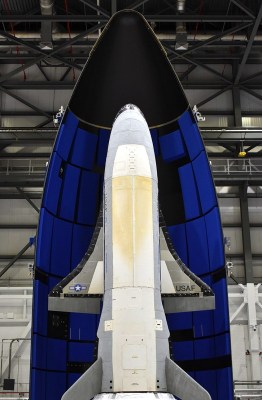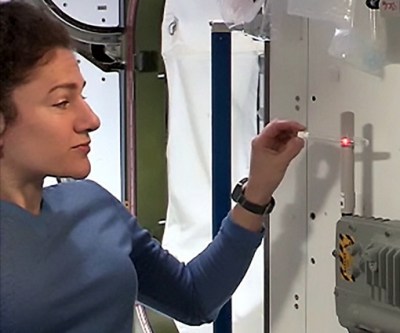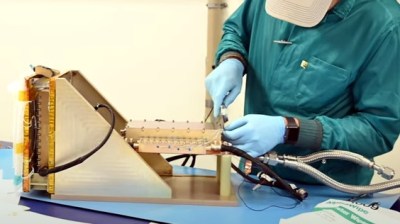Since 2010, the United States military has been operating a pair of small reusable spaceplanes that conduct secretive long-duration flights in low Earth orbit. Now officially operating under the auspices of the newly formed Space Force, the X-37Bs allow the military to conduct in-house research on new hardware and technology with limited involvement from outside agencies. The spaceplane still needs to hitch a ride to space on a commercial rocket like the Atlas V or the Falcon 9, but once it’s separated from the booster, the remainder of the X-37B’s mission is a military affair.

So naturally, there’s a lot we don’t know about the USSF-7 mission that launched from Cape Canaveral Air Force Station on May 17th. The duration of the mission and a complete manifest of the experiments aboard are classified, so nobody outside the Department of Defense truly knows what the robotic spacecraft is up to. But from previous missions we know the craft will likely remain in orbit for a minimum of two years, and there’s enough public information to piece together at least some of the investigations it will be conducting.
Certainly one the most interesting among them is an experiment from the U.S. Naval Research Laboratory (NRL) that will study converting solar power into a narrow microwave beam; a concept that has long been considered the key to unlocking the nearly unlimited energy potential offered by an orbital solar array. Even on a smaller scale, a safe and reliable way to transmit power over the air would have many possible applications. For example it could be used to keep unmanned aerial vehicles airborne indefinitely, or provide additional power for electric aircraft as they take-off.
Performing an orbital test of this technology is a serious commitment, and shows that all involved parties must have a fairly high confidence level in the hardware. Unfortunately, there isn’t much public information available about the power beaming experiment currently aboard the X-37B. There’s not even an indication of when it will be performed, much less when we should expect to see any kind of report on how it went. But we can make some educated guesses based on the work that the Naval Research Laboratory has already done in this field.
Starting (Very) Small
As it turns out, the X-37B experiment won’t be the first time the Naval Research Laboratory has demonstrated the concept of wireless power transmission in space. In April, astronaut Jessica Meir verified that the Lab’s light-emitting rectifying antenna (LECtenna) worked as expected aboard the International Space Station (ISS). Although hailed as the first practical test of this concept ever performed in orbit, the scope of the experiment was more limited than you’d probably expect.

The LECtenna demonstrated on the ISS was nothing more than a standard LED and a Schottky diode that had their leads twisted together. Secured in a clear plastic tube, the simple circuit is able to flicker the LED when in close proximity to high frequency energy. In a video on the NRL YouTube channel, Meir brings the simple LECtenna to within a few millimeters of one of the Station’s WiFi access points to prove that the concept works.
Realistically, this demonstration was more about public relations than anything. At the end of the video, Meir explains that viewers can construct their own LECtenna that they can use to visualize energy around their own homes.
In a companion video, an NRL researcher goes through the step-by-step process of building a LECtenna. He concludes the presentation by inviting educators to use the video as part of an interactive lab. It would seem that some inside the NRL want to make sure the people are educated about wireless power transfer, and considering how certain elements of the public can respond to new technology, it’s probably not a bad idea.
Even if it offers limited practical application, the LECtenna demonstration aboard the ISS does essentially work the same way that a proper space-solar installation would. Sunlight gets converted into electrical power by the Station’s solar array, which in turn is used to generate 2.4 GHz electromagnetic radiation in the form of standard WiFi. The small fraction of this radiated energy that was captured by the LECtenna, was then converted back into a DC voltage which lit the LED. But can it be done on a larger scale?
Now You’re Playing With Power
The hardware that the NRL has sent aboard the X-37B, known as the Photovoltaic Radio-frequency Antenna Module (PRAM), aims to find that out under real-world conditions. Using a 12-inch square photovoltaic panel, the device will convert sunlight into electrical power that will drive a high frequency generator. From the published information it’s not immediately clear what the receiver side of the experiment looks like, though presumably there will at least be some method of detecting the amount of microwave energy being radiated from the PRAM.

According to a NRL press release, a major focus of this experiment will be to study the thermal properties of the PRAM while in operation. Keeping the temperature stable could prove to be a challenge, as the cooling system not only has to contend with whatever heat is generated by the microwave electronics but intense sunlight. One of the major advantages of space-based solar power (SBSP) is the extended collection time compared to the surface of the Earth, so the hardware would need to survive nearly continuous operation for years or decades.
It’s unlikely the PRAM will actually be used to send power back down to Earth. Given the immense losses that could be expected (SBSP proposals usually assume transmission losses of around 60%), the amount of energy that would reach the surface of the Earth from such a small solar panel would have no practical application. Though such a sufficiently sensitive receiver, it’s possible that some effort might be made to at least detect the energy beam from a ground station.
The Spear of Destiny
If made practical, space-based solar power could greatly reduce our dependence on fossil fuels while simultaneously addressing the shortcomings of contemporary renewable energy sources and the stigma of nuclear power. Short of perfecting fusion power, it may well be humanity’s best chance at meeting its immense power requirements in a responsible and sustainable way.
Given the incredible importance of this research, one might wonder why it’s being tested on a shadowy military spacecraft rather than the International Space Station or even a dedicated satellite. While it’s nothing more than conjecture at this point, there are some that believe that the military has a vested interested in the technology and wants to see it developed as quickly as possible.
 It’s certainly not hard to see why. The ability to beam power to vehicles and bases on the front line with no concern over local infrastructure would be an incredible tactical advantage over the enemy. The Space Force is surely interested in weaponizing the technology for space-to-space engagements as well. Any microwave transmitter powerful enough to overcome atmospheric losses and deliver a useful amount of energy to the Earth’s surface could easily be repurposed as an anti-satellite weapon.
It’s certainly not hard to see why. The ability to beam power to vehicles and bases on the front line with no concern over local infrastructure would be an incredible tactical advantage over the enemy. The Space Force is surely interested in weaponizing the technology for space-to-space engagements as well. Any microwave transmitter powerful enough to overcome atmospheric losses and deliver a useful amount of energy to the Earth’s surface could easily be repurposed as an anti-satellite weapon.
Just as the Global Positioning System started as a military project and evolved into something used by civilians on a daily basis, solar power from space could get its start as an instrument of war. It might not be a particularly pleasing thought, but if it means that the technology gets developed faster and can ultimately be pushed into service for more peaceful endeavours, it might be a price worth paying.
















LECtenna?
Radio-Electronics showed how to make one decades ago.
Yes, it was just a RadioShack Schottky Barrier Diode (SBD) with an LED in parallel, reverse biased.
Radio-Electronics called it a Microwave Oven Leakage Detector.
The LED was soldered close to the SBD, the leads of the SBD acted as the antenna. As microwaves were received by the “antenna” the SBD rectified the signal. When the rectified DC reached a high enough potential, the LED lit.
I built a number of these “LECtennas”, taped them to Popsicle sticks (about 4 cm from one end).
I gave some to friends, but one is still in my toolbox.
I compared the “LECtennas” I built to the Microwave Leakage Detector at work, and the LEDs consistently lit in the “Yellow” range, indicating leakage one could begin to be concerned about. (bent oven door, rust/crud buildup, damaged door seal, etc.)
These were popular in the 90’s when you had blinker toys that would light up when your Nokia 5110 got a text message.
Oh I love those, do they still work on modern phones? I really want one.
They should work, the SAR values of the old phones are about 150% of the modern smartphones.
The difference is that in the old GSM phones, when the network queries the phone, the phone answers at full transmitting power and then dials it down when the connection is established. Modern phones are pretty much continuously online and sending updates, so they don’t necessarily have the same burst of power that makes the LED blink unless you’re dropping down to 2G.
My new-ish phone makes the sub on my home theater system buzz if it’s within about 2 feet and someone is calling. So I would imagine there is some detectable change that’s unique to incoming calls/messages.
I would imagine it does the same whenever whatsapp hails the server to send out spy messages to facebook, so you wouldn’t be able to tell from the blinks whether there’s a message or a call coming, or just google spying on you.
Try putting your 4G or 5G cell phone in your Microwave. Close the door (DON’T TURN THE MICROWAVE ON!) Then use another line to call you device. Let me know if it rings. Mine does, and its a new Microwave. Your thoughts?
I once did this with an older generation phone and a cookie jar with fully enclosed metal lid, and it also worked.
Capacitive coupling to the inside is apparently enough for the cookie jar to work as both a receiving and transmitting antenna.
Earthing the cookie jar would probably have prevented this, but how do you make a good enough earth connection at those frequencies?
4G operates at 2600 MHz and 5G at 3400 MHz which is sufficiently different from 2450 MHz that the microwave’s design doesn’t block it as it’s designed to do.
To leak out through a gap between the microwave door, or from the lid of a cookie tin, the hole only needs to be larger than half the wavelength along ONE axis, so the cellphone signal can escape through a tiny crack that is about 2″ long.
Just an FYI – Verizon’s 5G Ultra Wideband network uses 28 GHz and 39 GHz according to their FAQ’s Sprint is using 3 different frequencies for their 5G, and one of them is 2.6 GHz you listed for 4G which is spot on in your answer.
The USA carriers use overlapping frequencies for 4G and 5G. Higher frequencies (28 & 39 GHz) in cities where they can have more antennas, but they throttle back along highways because there are fewer antennas so they need the longer wavelengths to travel further. T Mobile uses the lowest frequency at 600MHz for their 5G which is why I think they advertise better coverage, but they cannot guarantee the speed, unless there are fewer older phones using that frequency because the 5G technology eats bandwidth.
I don’t have AT&T’s specifications yet.
Microwave oven leak detector where all the rage in the 80’s/90’s then completely fade out of existence.
I guess it will be the same for all gsm/3/43/5G luddites…
I was under the impression that the losses would be high in a orbit to surface beam due some pesky issues with atmosphere and moisture, the inherent heating of such. I hope they are able to overcome them, hate to think we’d end up still have a ‘global warming’ issue because of it.
No worse that what we have now. 60% losses might sound atrocious, but all existing thermal plants have similar efficiencies. It is not a major component of global warming because its only about 20 TW, which is much less than 1/1000th of the energy we get from the sun. It is not a significant component of global warming.
The main complaint against microwave transmission of energy is rather that it can’t be done safely. When you’re out, you can wear a shirt and that blocks the radiation from the sun – but when you’re concentrating similar levels of RF energy at 2.4 GHz, it goes through your shirt and about 17 mm into your flesh. That’s a nasty “sunburn”. Yet that’s the only way you’ll be able to collect it reasonably, because using low power densities means you have to spread the collector over a whole county.
1 kW per square meter is 1 GW over a square kilometer. If you want to experience how that feels like, bypass the safety switch in your microwave and open the door, then stand about half a meter in front of it while it cooks.
This is missing critical Information about wavelength.
UVA rays cause tanning, and the shorter wavelengths of UVA also cause sunburn.
UVB rays (and shorter wavelengths reaching the skin) cause sunburn, because the photons are in the range where they have high enough energy to break molecular bonds.
Longer wavelength photons (visible light, infrared, microwave, radio) cannot cause sunburn, because there isn’t enough energy per photon. They will transfer heat, as anyone who has been in the sun knows, but cannot cause sunburn. Or tanning. There are no microwave tanning beds, they wouldn’t work.
I’m kind of unclear about why you talk about taking your shirt off, followed by “that’s the only way you’ll be able to collect it reasonably”. Would you be against concentrating solar collectors because your hand would be burned if you stuck it into the focal zone? Woodstoves? Ovens? Home heating furnaces?
For safety, seems like it’s only important to keep the energy density reaching people (and wildlife) low enough to prevent thermal injury.
>I’m kind of unclear about why you talk about taking your shirt off
I don’t. I’m certain your complaints would be answered if you bothered to read mine.
You can avoid having a heat stroke in the sun by putting on a hat and a shirt to increase your reflectance. That way much of the energy isn’t absorbed by your body. When there’s 1 kW of microwave energy beaming down, the hat and shirt won’t do anything because they’re transparent to the wavelength and your body is not. People and animals will be slowly cooked to death.
Yet you can’t avoid this because you have to concentrate the microwaves in order to pick them up efficiently. If you spread it out to reduce the heat load, you’ll have to deal with collectors of enormous size and cost.
If you want to experience 1kW per square meter of electromagnetic energy, go outside on a clear day with no clouds.
Solar radiation at the Earth’s surface is about 1kW per square meter.
https://en.wikipedia.org/wiki/Solar_irradiance
True, so there should be no trouble to add another 1 kW to it and still stand around like nothing.
The reason this is concerning is because the receiving antenna won’t pick up all the energy. You may at best hope for 10-20% efficiency, so in order to transmit a gigawatt of power down from the sky, you have to irradiate 5-10 square kilometers at 1 kW per square meter.
To add insult to injury, the diffuse scattering of the beam would probably put out wifi in the entire state.
Oh, I think a good story to read about satellites converting sunlight to microwave energy to beam down to Earth is
Isaac Asimov’s “Reason”
https://en.wikipedia.org/wiki/Reason_(short_story)
+1
DoD’s interest is probably related to the large number of batteries they need on an operation. This might supply a means or recharging them which was more portable than ground based solar panels. Particularly important for a covert SOCOM base engaged in close in ELINT activities.
Of course, if the system malfunctioned it could become this random death ray that swept the earth frying everything it hit.
I would that a beam providing power to field ops would be observable thus negating otherwise useful effect
Especially if you are beaming on the enemy!
B^)
>Of course, if the system malfunctioned it could become this random death ray that swept the earth frying everything it hit.
I was going to say, halfway through the article I thought, “I’ve played enough SimCity 2000 to know where this is going…”
Sorry if I’m simply restating what Reg said…
Recharging satellite battery banks would make even more sense if a dedicated satellite could be tasked with the job of harvesting and beaming the energy to a larger quantity of battery-powered satellites. With a dedicated “recharger satellite” in service, it may be easier to create dedicated satellites that store and use power without the size/weight challenges of solar power collection.
tldr; Many satellites can be serviced/powered by one mobile power harvester/beamer.
I think the size of collector the satellites would need to sufficiently charge would be larger/bulkier than solar panels. But they might be less fragile.
Just a few questionable assumptions here. No failsafes, beam focus maintained, dwell time long enough to do damage yet sweeps fast enough that it does significant travel before being shut down…
>Any microwave transmitter powerful enough to overcome atmospheric losses and deliver a useful amount of energy to the Earth’s surface could easily be repurposed as an anti-satellite weapon.
The usual scheme is to set up large antenna array fields to pick up the energy at ground, because the spread of the beam is too wide to point it at a single vehicle or building. It’s like making an artificial microwave sun that shines on a large area collector consisting of a grid of antennas. The spacing between the antennas depends on the wavelength used. In theory with low microwave frequencies, you only need one piece of wire sticking out every yard or so, so you can lay a mile-wide porcupine mat across a desert and point your transmitter at it.
It’s still difficult to beam at something a mile wide when you’re 300 miles up and moving. You’ll be diffraction limited by the small size of the transmitting antenna or dish.
Can anyone explain the reason why I need a Schottky diode for a LECtenna? I know that they have a lower voltage drop than silicon diodes, but the LED voltage drop is much higher…
They’re faster, so they can respond to microwave frequencies.
Thank you, this makes sense! By the way, I’ve just built one. Some leakage from the door of my microwave… Cool
Thinking might not be a bad idea for powering earth orbit operations from strategically positioned concentrating or utility like stations. Might help ease future payloads to increase what can be deployed over time.
This has been in the works for a long time. I remember reading about this over a decade ago and even then there was an actual plan of action.
It’s taken a long time to get to even semi public.
If it were used for the general public it would mean unlimited space to set up solar panels. It would also mean someone could disperse metal dust in the atmosphere and disrupt the beam. To truly be reliable they will need an array of these to send electricity, not only to the ground, but also pass it between satellites to distribute it and redirect it if a satellite is destroyed. They could also act as maser weapons if pointed at an unprotected satellite. Satellites will need artificial magnetospheres and before you know it the arms race will be made public.
I remember talk of it from themid 80’s. It was “abandoned” back then because of how it could be used a s a directed energy weapon. The powers that be (back then) were afraid it would intensify the arms race.
These days the US doesn’t seem to think it will bite them in some way or another.
Bush canceled the ICBM treaty, Trump the INF and there is talk about ending the “open skies” treaty. All of this is making all of us less safe, this cannot lead to anything good imo.
Finally, they have been experimenting with these things for decades, in Canada they flew experimental electric models using beamed microwaves.
Power relays are a practical and efficient means to transfer energy in space. Not so practical on earth but space yes. It certainly would make certain aspects of missions much more practical.
“LECtenna.” Sad.
I’ve got one I built into my hatband. Far cooler and better looking.
https://josepheoff.github.io/posts/1-hatband
and functional
Nice write-up, thank you Joseph. This should be featured on Hackaday!
I very much doubt that space based solar power will ever be commercial viable. Too much capital investment with a lot of risk. It would probably be more like Iridium than GPS.
Especially since we still have plenty of prime space on Earth to install solar panels.
What? There is a WiFi access point on board of the ISS? I wonder if a large enough dish and an amplifier could… 🤔
Another interesting question is if the network(s) have password security so the neighbors to steal service. :-)
No, because the round trip delays would be too much, even if you could overcome the signal strength problem.
Aaaaah, it burns, it burns!
Did Tesla not envision this?
My first thought was that this should be a Dept of Energy project, but then I remembered that i had heard about the military looking into electrifying everything. When I heard that i was wondering how they were planning to recharge during a battle. I guess this could be a solution.
Japan has been at this for a while now. I think it’s quite awesome
https://spectrum.ieee.org/green-tech/solar/how-japan-plans-to-build-an-orbital-solar-farm
Just a crazy thought. What if you point it towards Mars rovers could you hit a target that small with enough power to charge their batters? Or maybe long range satellites